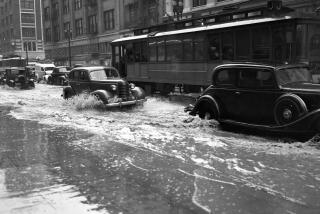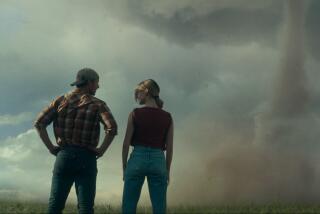Funnel vision
Ames, Iowa — May 29, 2004. About 50 tornadoes set down from North Dakota to Oklahoma. In Missouri, three people are killed and about 18 injured. One man dies shielding his children as his mobile home is blown across the road. Farther north, two women are killed when their home is swept away.
It’s a beautiful day in the heartland of America. But for storm chasers, weather geeks and other pressure-drop thrill seekers, the weather is really bad when it’s really good, and on this weather-less morning in Iowa, it’s terrible. Roads end in fields of yellow mustard flowers. Tractors spit along gravel roads. Tourists speed past old white farmsteads, Cyclone liquor stores and convenience marts. Luckily, everything can change in an instant.
Almost 10 years after the Hollywood blockbuster “Twister” introduced the world to tornado-obsessed individuals who haunt Tornado Alley each spring, Mark Svenvold is on the scene, and his book, “Big Weather: Chasing Tornadoes in the Heart of America,” is the weather watcher’s new guide to the world of storm chasing.
“I love the sky,” Svenvold proclaims. He’s just given a breakfast talk at Iowa State College. Six-four, strikingly good-looking, he stands out like a beat poet at an ice cream social, probably the only person dressed in black within a 50-mile radius. It’s the last stop of his book tour, and he’s eager to get out of town.
When Svenvold says he loves the sky, you realize that it is no different for him than Himalayan massifs are for climbers or the Southern Ocean for sailors. Its magnitude, its majesty, its ability to bring the world to its knees -- in all its tragic dynamism -- attracts him.
“Chasing is a quasi-spiritual quest,” he says. “When you come upon a storm, the world changes into a shadow world, a world that has been taken over. You have to think spatially under the cloud base. ... You have to translate what you see into God’s view.”
After the reading, he makes a couple of calls. He hopes to catch up with Imax filmmaker Sean Casey and with meteorologist Joshua Wurman, who has been on the road since morning.
“Go west,” Wurman advises, “and call me in a couple of hours.”
Svenvold wastes no time loading up a rented Chevrolet with Doritos, Mountain Dew and Wrigley’s Winterfresh gum. He hits Route 30, and Ames disappears fast in the rearview. Somewhere in the West, a line of thunderstorms extends from New Mexico to central Nebraska. Tornadoes are reportedly touching down in northeastern Colorado.
In Denison, Svenvold turns south on 59 to connect with Interstate 80. Around 3 p.m., clouds have started to form. By now, he’s well into Nebraska, and just past Kearney, he calls Wurman who tells him to head south on 283. Three hours later, at a gas station in Arapahoe, he overhears a warning for severe storms.
The woman behind the counter slaps the radio, as if it’s broken: “Won’t hit here,” she growls. “Never does.”
Apocalyptic dreams
April 20, 2004. Several dozen tornadoes touch down in Illinois and Indiana. The worst hits Utica, a small town 90 miles southwest of Chicago. Sirens give residents three minutes to prepare. Some 18 people take refuge in the basement of the Milestone Tap Restaurant, a three-story, century-old building. The structure collapses.
Consider what we know. Each year, approximately 10,000 severe thunderstorms cut across the United States. Out of these, more than 1,000 tornadoes occur. Three-quarters of the tornadoes in the world form in a region known as Tornado Alley, which stretches as far north as South Dakota and south into Texas. May and June are the worst months of the season.
During these months, the interstates and highways of the Midwest fill with storm chasers. On one side of the spectrum are the yahoos, people who put their foot on the accelerator without knowing why (storm chaser tour groups -- vans filled with people who pay several thousand dollars for the chance to see a tornado -- belong to this category). On the other side of the spectrum are the scientists, who are out here to learn more about these storms with the hope of someday saving lives. And in between are the artists, filmmakers and photographers who are fascinated by the spectacle, while sprinkled about are the Internet nerds who spend hours each day on sites such as WX-Chase listserv and www.stormtrack.org.
Svenvold is somewhere in the middle. Munching Doritos and speeding south, he talks about how he left his hometown of Seattle in 1990 for the Iowa Writers’ Workshop and worked as a tour guide in Alaska for two years before moving to New York City, where he met and married novelist Martha McPhee, daughter of author John McPhee.
Sometime in college, he started dreaming -- “apocalyptic, beautiful dreams” -- about tornadoes. There’d be one “coming down Broadway in Seattle,” he remembers, “salmon, animals, various fish, all floating in it, and it would stop at the light.”
Storm chasing is something of a pathology. Ben Franklin, as legend has it, was the first storm chaser, following a tornado by horse until flying tree trunks convinced him that his life was in danger. Modern storm chasers (“social misfits,” says Svenvold; species, Meteorologica migratorius) exhibit the same common sense and curiosity as Franklin, and their numbers are growing.
Svenvold veers south into Kansas. Mammatus clouds, dark, gray and ominously sagging formations, stud the sky. A tornado watch, one level below a warning, is issued by the Storm Prediction Center for Red Willow County, Neb.
Certain trees glow as if they’ve been chosen. In the town of Cambridge, just west of Arapahoe, homeowners are in a frenzy of lawn mowing to beat the rains. Just about sunset, the hail starts to fall. A tumbleweed hits the car and Svenvold realizes he’s entered into the approaching storm, but he wants to avoid the hail, which normally occurs in the northern side of a storm cell. It’s bad form, he explains, to “punch the core,” which is exactly what he’s doing.
Good storm chasers pride themselves on choosing the right storm out of many -- the one most likely to pop -- and on positioning themselves to get a good view of it. Being out of position is considered feeble.
He checks the map as the radio announces severe thunderstorms and tornado watches in various counties. He calls Wurman.
“We’re inside something here,” Svenvold says. “We’ve got CGS right here.”
It’s a good sign. CGS means cloud-to-ground lightning strikes, one indication of storm escalation. Svenvold follows the Republican River west and stops for something to eat at a roadhouse in Trenton, Neb. Just as he orders, the lights go out.
“Not again,” moans someone in the crowd at the bar.
“Let’s all freak out,” says an old guy.
“We never get hit,” says the waitress, echoes of Arapahoe. “Last tornado here was in 1967. Sure, we get small ones.”
At the next table, four storm chasers from the Netherlands are nursing their beers. They’re disappointed in the weather.
Back in the car, Svenvold cranks up the evangelical music for no particular reason. It’s the Swift singing “I Need You.” The radio announcer has upped the ante from quarter-sized hail to baseball-sized. IGOR II, the disembodied computerized voice of the National Weather Service, calls the dance.
“It’s like being carpet-bombed” says Svenvold happily as bolts of lightning bifurcate the sky and fizzle out in the bristling grass. He’s driven more than 600 miles when he pulls into a motel lot in Goodland, Kan. He’s finally made our rendezvous. In the parking lot are Wurman’s trucks with mounted Doppler satellites and Casey’s Tornado Intercept Vehicle with its bulletproof laminate, a turret and portholes for the Imax cameras.
That night the Weather Channel warns viewers to “stay away from the windows.”
‘The sensational side’
Nov. 23, 2004. A two-day swarm of mostly small tornadoes strikes the southern United States. A 77-year old Texas woman is killed when her trailer is destroyed. A few hours later, the worst tornado of the lot hits the small town of Olla, La. More than 100 homes are damaged or destroyed.
In the morning, it’s standing room only as Wurman’s convoy meets for the daily briefing in the motel room. Meteorologists and graduate students from Penn State, Oklahoma University, Duke and Purdue overflow out onto the balcony. On a laptop, a graduate student runs various weather models. Another plots the day’s trajectory of storms.
Although most cells formed the day before to the south, many of them have collapsed. The problem is too many storms forming in close proximity. So the question is simple: Which one is most likely to bloom into a tornado? To the west, there’s less moisture but the ground’s a little higher, and higher elevations compensate for low dew points. After much discussion and guesswork, the group agrees to head north and west.
Big weather is big money, generating about $300 million in annual revenue for research institutions, and there’s a lot of pressure on meteorologists to make accurate and timely predictions.
With a finite time period for data collection and seemingly infinite amount of ground to cover, Wurman and Casey have found it useful to collaborate.
Wurman’s Center for Severe Storm Research in Hays, Kan., is in the first phase of a 10-year study of tornadoes. VORTEX 1 is an effort to catalog various types of storms, understand how and why they form, and, along the way, provide data that will help modernize the 35-year-old Fujita scale, a damage measurement scale. Since 1995, his crew has cataloged 120 tornadoes, 22 this season alone. The operation, primarily funded by the National Science Foundation, costs about $1,000 a day. (VORTEX 2 will begin in 2007.)
This year Wurman, who could be a stand-in for Russell Crowe, has been focusing his Doppler radar on the lower portions of tornadoes in an effort to better understand ground-level winds. The Dopplers, which are mounted on two trucks, are the key to the success of this mission.
“With the DOWS [Dopplers on Wheels],” Wurman says, “we can get 10,000 times better detection than any other radar system, including the National Weather Service. We scan 30 times faster. Instead of one beam, the DOWS shine six beams that comb through the sky at once.”
To gauge the size and the power of the storm -- and to collect more data -- Wurman uses Casey’s Tornado Intercept Vehicle, which can drive into 150-mph winds, putting the vehicle within half a mile of the storm. Wurman’s crew gives the driver directions via radio, while Casey films from the turret. It’s a vantage that he’s accustomed to.
Dressed in camouflage shorts and dark glasses, Casey is the Rambo of the High Plains. As the photographer on the Imax film “Forces of Nature,” he’s experienced plenty of storms. Of the worst, one in Paducah, Texas -- where the winds were clocking 110 mph -- he says, “It’s like being underwater. You know there’s a shark, but you don’t know where. The vortex is sucking up air, 250 miles per hour of sheer power ... an amazing spectacle.
“I’m here,” he adds without a trace of apology, “for the sensational side of it.”
Casey plans to spend up to seven weeks a year through 2008 capturing footage of tornadoes, a project paid for by the National Geographic Society. During a recent tornado, Casey measured 122 mph winds near the ground while the DOWS measured even higher wind speeds 60 feet up.
The big buildup
May 22, 2004. Storms, towering 65,000 feet high, spawn at least 20 tornadoes in southeastern Nebraska. Worst hit is the town of Hallam, about 25 miles south of Lincoln. Thirty-seven people are injured, and a 73-year-old woman dies when her home collapses.
Svenvold finds himself at the end of the convoy, heading west on Route 34 toward Wray, Colo. A wave of chasers in white vans going 90 miles an hour pass us, antennae and hydrometers bobbing up and down. Clearly, something’s up.
Tour group drivers are known among chasers for their bad manners on the road. Perhaps it’s the pressure of charging hundreds of dollars a day that makes them honk and hog the road and cut people off.
“I’d rather not see ‘em,” says Doreen, a cashier at the Wray Supers after a group alights in the parking lot. “They give me a weird feeling, like something bad is going to happen. Had one of those tornadoes about 25 years ago. But usually they go right around us.”
One of the graduate students comes over the two-way radio complaining about them in a pure Cockney accent laced with distaste and shot through with invective. (“This is our damn storm,” she says.)
Svenvold puts Neil Young’s greatest hits on the CD player to drown out the bad juju and keeps on driving. “This old world keeps spinning round,” Young sings. “It’s a wonder tall trees ain’t layin’ down.”
By 3 p.m., storms are collecting to the left and right of us. A big anvil shape, white flat-bottomed with a puffy soft top, looms over the windshield. It begins a ghostlike spiraling and then fades. Suddenly, it’s as if all the clouds are spiraling. Outside the car, the wind changes. The air is slightly warmer, pouring along at 60 mph, feeding the storm ahead.
The Dopplers are deployed and spinning and triangulating. Gusts tear through tall grass as we pass through Akron, Colo., population 4,662, about 100 miles east of Denver. Every nerve cell has been activated.
“SLCs,” says Svenvold. “Scary Looking Clouds.”
But the storm is having trouble organizing. The convoy stops on the side of the road to watch.
“Just do it,” yells a student, a yellow bandanna tied around his neck. A deep aquamarine section forms within the dark grayness of the clouds, a beckoning, seductive place. The storm is a little more than one mile away. Lightning strikes seem immaterial to the bigger purpose. Someone spots a new base, a new cell forming from the old cell. It’s coming in from the north on a storm moving east. High winds are blowing slushy hail.
“We’re gonna get smacked by outflow in a second,” yells Wurman, and sure enough, a gust of rapidly cooling air swirls around him. It’s not a promising sign.
“It’s a weak rotation,” someone yells.
“Do it! Just do it!” yells the guy in the yellow bandanna, frustration edging into his voice.
And then there is silence.
Two hundred and twenty miles later, Svenvold, Wurman, and Casey and company have come full circle. They’re back in Goodland, the motel parking lot clogged with vehicles.
Wurman and his crew gather for dinner in a local restaurant. In the next room, the balls colliding on the pool table sound like thunder, setting the team on edge for nearly two hours. Outside, in the distance, a freight train -- the sides of its cars brightly painted J.B. Hunt, Maersk, Southern Pacific, Union Pacific, Conrail, Norfolk Southern and Santa Fe -- slides across the horizon.
“Here we are in the present,” says Svenvold. “Nowhere, in transit. Present progressive -- the most seductive period of time.”
Here we are. Addicted to it.
*
Susan Salter Reynolds can be reached at susan.reynolds@latimes.com.
More to Read
Sign up for The Wild
We’ll help you find the best places to hike, bike and run, as well as the perfect silent spots for meditation and yoga.
You may occasionally receive promotional content from the Los Angeles Times.






